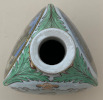A FINELY DECORATED TRICORN PRATTWARE BOTTLE FOR 'SOYER'S RELISH'
Made by F.& R. Pratt & Co. A special limited edition Prattware bottle ordered by Messrs Crosse and Blackwell. With the shape and design to Alexis Soyer's specifications.
ITEM # 1 - n/d circa the 1850's. 195mm tall x 110mm wide. Decorated on three sides. Side 1: The famous portrait of Soyer in his trademark cocked beret, painted by his equally famous wife Emma Soyer [nee Jones]. There is an 6mm very slightly raised flake on the base under Soyer's portrait, but not detracting. Side 2: The Fish-market. Side 3: The Poultry-woman. There is a very fine 1.5" heat crack to the glace. on the lower part of the neck. Beautifully painted and decorated with raised ceramic piping in green, maroon and gold. A few gold lines on the neck are very slightly worn. ITEM # 2 - A one-page letter folded in half with the script on 1/4. 8vo. Signed by Soyer. It has presumably been written by a secretary in a lovely cursive script at the Reform Club Pall Mall, dated April 17th 1848. It starts; Dear Sir I am sure you will be delighted to offer your fair readers something to sharpen their appetites and please their palates, I therefore by your acceptance of a sample of my last culinary production and hope if it should meet with your approbation that you will recommend it as a favourite relish to amateurs of good living. I am most truly yours A. Soyer. It has then been folded again and addressed to the Lady's Newspaper. At some point it has been sealed for delivery. Now kept securely in a marbled cardboard folder. Both items housed for preservation in a very solid clam-shell box: 270 x 200 x 146mm. Quarter maroon morocco with tips. Spine with raised bands and two green morocco labels with gilt lettering. Green cloth sides. The interior with padded dark green felt cushioning. Everything in very good condition.
- - This bottle originally contained "Soyer's Sultana Sauce" and marketed by Messrs. Edmund Crosse and Thomas Blackwell as "Soyer's Relish", The whole design is definitely in keeping with the style of Soyer's 'a la zoug-zoug' predilection. (To understand what this means, see item #10991 on this site) and read George Augustus Sala's very interesting description of Alexis Soyer's eccentric design and style bias. Soyer manufactured his first piquant sauce; "The Lady and Gentleman's Sauce", in 1848, priced 2s 6d. He also marketed it himself [see image # 6 below]. The letter was addressed to the editor of the 'Lady's Newspaper'. Soyer was an inveterate self-promoter and obviously had a full quota of marketing skills as well. Due to his own efforts, the Relish was extremely popular and he intended to keep the recipe to himself but he was typically very busy with other pursuits. He agreed to a meeting with Crosse & Blackwell. Finding the terms offered for the recipe to be very advantageous, he sold it to them. Then in August 22nd, 1850 [ref: Lon. Metropolitan Archives #MA/4467/A01/003. Declaration of Goods Quality] he brought out "Soyer's Relish". From its inception, it was well patronized above and beyond expectations. Because of its great popularity, Crosse and Blackwell commissioned a limited amount of this very special bottle from F. & R. Pratt & Co. Whilst Felix Pratt was the commercial driving force behind the business, the artist was Jesse Austin who joined Pratt in the early-1840's. He was an accomplished water-colour artist and engraver and in nearly 40 years produced over 550 poly chrome prints used to decorate the now well-known small pot lids manufactured for many types of potted food-stuffs. Pratt’s first under-glaze, polychrome pot lid was made in 1847 and was a scene titled ‘Grace before Meals’. Austin’s subjects included royalty, famous people, city scenes. (The portrait of Soyer here is a copy of the famous image painted by his well-known artist wife, Emma Soyer nee; Jones, now hanging in the Nat. Portrait Gallery, London). This portrayal of the life and times of Victorian England is one of the reasons for the popularity of the pot lids today. Austin also made miniature water-colour copies of famous paintings that also appear on Prattware. Although the pot lids have become well known, the engravings were also used on the pots themselves, on plates and on other domestic earthenware manufactured by the business. It is this good-quality domestic pottery that is termed ‘Prattware’. So good were the engravings that the pot lids and Prattware rapidly became a collectible and the first exhibition was apparently held in 1897 only three years after Felix Pratt’s death. Cauldon Potteries Ltd acquired Pratt & Co in 1933 and continued to issue reproduction pot lids under the F. & R. Pratt name using the original Jesse Austin engravings and the practice was continued up to the 1960s by the various owners of the Pratt name. It is not known how many of these exotic and unusual tricorn 'Soyers' Relish' bottles were produced and sold, but one that came up for auction on July 2004, sold for four times the projected price. A very collectable object with the very rare signed letter pertaining to the bottle and it's past contents.






click on image to enlarge

Ephemera category
ref number:
11296